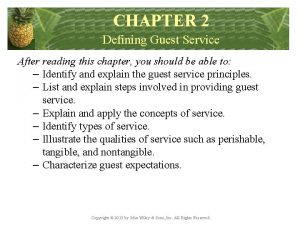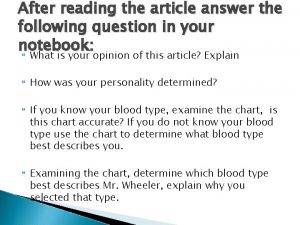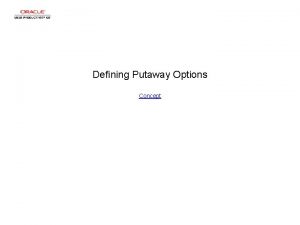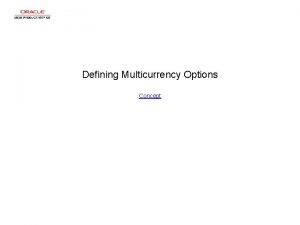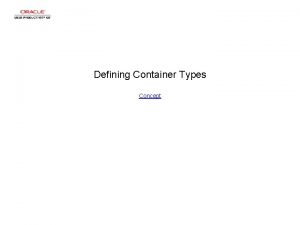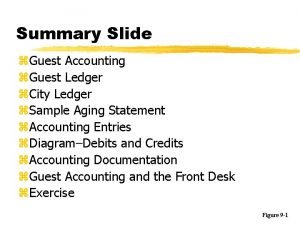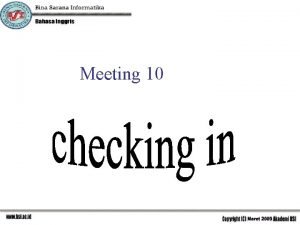CHAPTER 2 Defining Guest Service After reading this





















- Slides: 21

CHAPTER 2 Defining Guest Service After reading this chapter, you should be able to: – Identify and explain the guest service principles. – List and explain steps involved in providing guest service. – Explain and apply the concepts of service. – Identify types of service. – Illustrate the qualities of service such as perishable, tangible, and nontangible. – Characterize guest expectations. Copyright © 2013 by John Wiley & Sons, Inc. All Rights Reserved.

(recap) Defining Quality Guest Service • Definition: Exceeding guests’ expectations. – There are many definitions for quality guest service available. – The challenge with this definition is that much work goes into consistently pleasing the guest. Copyright © 2013 by John Wiley & Sons, Inc. All Rights Reserved.

Aspects of Guest Service • • Focusing on serving the guest Consistency in service Efficiency in service Guests defining quality and value Knowledgeable employees Commitment from the top of the organization Processes that allow service to continually improve Copyright © 2013 by John Wiley & Sons, Inc. All Rights Reserved.

Perishability of Service • You cannot inventory service. • It is not a commodity. Copyright © 2013 by John Wiley & Sons, Inc. All Rights Reserved.

Advice for Providing Guest Service (cont’d) • Listen to the customers. – Empathize with and assess the customers feelings first. – Let them know that you care for their needs and have a sincere interest in their satisfaction. • Exceed guests’ expectations. – Be responsible for customers’ satisfaction. • Treat the customer as the most important part of your job. – Notice the specific needs of each customer and provide those extras that are more than what the customer expects. Copyright © 2013 by John Wiley & Sons, Inc. All Rights Reserved.

Advice for Providing Guest Service (cont’d) • Know your products and services. – Know the procedures of your company and the industry. – Use this information to make things better and easier for the customer. • Be professional. – Present yourself well, using verbal and nonverbal communication. – Take pride in yourself, your company, and your job. Copyright © 2013 by John Wiley & Sons, Inc. All Rights Reserved.

Top Three Attributes of Customer Service • According to MSN: – Knowledge of staff – Friendliness of staff – Readily available staff Copyright © 2013 by John Wiley & Sons, Inc. All Rights Reserved.

Types of Service • Assistance Service: – Involves basic service and meeting the expectations of the customer. Crucial to any business. • Example: Help choosing a good seat for the show • Example : Help choosing an appropriate wine • Repair Service: – Fixing a problem for a customer. It may have been a fault of the business. It is reactive, instead of proactive. It involves “putting out fires. ” • Example: Repairing a leaky faucet in a guestroom • Example: Helping a traveler find an alternative flight in bad weather Copyright © 2013 by John Wiley & Sons, Inc. All Rights Reserved.

Types of Service (cont’d) • Value-Added Service: – Involves exceeding customers’ expectations. • Example: Remembering a guest’s favorite drink Example: Offering a free upgrade Copyright © 2013 by John Wiley & Sons, Inc. All Rights Reserved.

Tangibles and Intangibles • Two of the most common components of guest service: – Tangibles – Intangibles • In hospitality, we sell an entire experience. • By breaking down each of the components, they can be: Monitored Evaluated Improved upon Copyright © 2013 by John Wiley & Sons, Inc. All Rights Reserved.

The Customer Ultimately Decides Q: Who pays the salaries of the management and the employees? A: Customers Q: Who pays the rent, the utilities, and the taxes? A: Customers • Lesson: – They should be treated as the ultimate critic, because ultimately they are. Copyright © 2013 by John Wiley & Sons, Inc. All Rights Reserved.

Meeting Guest Expectations • Truly great service is receiving more than you expected. • Expectations can also be categorized a few ways. – Evaluate the type of signals you are putting out as a business. – These signals begin to establish or set the level of expectations. – They can be explicit or implicit. – They make up the brand or image that you portray. • This idea is commonly referred to as brand management. – All decisions would be related to this central theme, from the wallpaper and décor to service style. Copyright © 2013 by John Wiley & Sons, Inc. All Rights Reserved.

Meeting Guest Expectations (cont’d) • Explicit expectations: – Those expectations that are fully expressed. – They are set by promises made by staff, contracts, menus, signage, advertisements, and service promise. • Implicit expectations: – Those expectations that are not fully expressed. – They are set by prices, décor, location, and service style. Copyright © 2013 by John Wiley & Sons, Inc. All Rights Reserved.

Levels of Expectations • Ideal Expectations • Reasonable Expectations • Minimal Expectations Copyright © 2013 by John Wiley & Sons, Inc. All Rights Reserved.

Order of Expectations • Primary expectations are generalizable to most hospitality settings. – They are the main wants and needs of the service experience. – Prepared and ready for the guest – Attentive, professional service – Efficiency – Comprehension of the process – Knowledge of the times – Wants are heard and understood – Follow-through of a product that is what it claims Copyright © 2013 by John Wiley & Sons, Inc. All Rights Reserved.

Order of Expectations (cont’d) • Secondary expectations are less important to basic, essential service and may be omitted with a certain level of tolerance by the customer. They are things that they take away from the guest service. Guests don’t usually mind until they become a larger issue, although it would certainly be best to provide all of these expectations in a desirable situation. – Knowledgeable, pleasant staff – Options made known – No transferring – Competence – Acknowledgment—know the customer. Or, respect their anonymity. Copyright © 2013 by John Wiley & Sons, Inc. All Rights Reserved.

Inputs that Set Expectations • Every customer is different. • There are many inputs that determine the individual customer’s expectations. – Some come from the business while others come from the guests. – As a result, the expectations may be low, high, or even undecided. – Defined by • Marketing • Operations • Inputs from guests • Self • Others • Occasion Copyright © 2013 by John Wiley & Sons, Inc. All Rights Reserved.

Providing Guest Service Basics – Become familiar with your customers, survey them. – Demonstrate your dedication to your customers. – Tell your customers what they can expect, then keep your word. – Develop your expertise and maintain consistency. – Treat all your customers and workers with the same high level of respect. – Apologize if you are wrong. • Remember that credibility is much harder to regain than it is to attain in the first place. Copyright © 2013 by John Wiley & Sons, Inc. All Rights Reserved.

Issues with Exceeding Expectations • “Consistently meeting expectations” – To give something extra doesn’t mean giving away your business. – It could mean personalizing a service, giving extra attention, recognizing a familiar face, or giving extra help with bags or the elevator. – Using the human touch is what makes hospitality what it is! Copyright © 2013 by John Wiley & Sons, Inc. All Rights Reserved.

Databases • “Developing lifetime relationships with the customers” – Large database with all of their customers’ information – Shared among properties – Keeps records of the guests’ profiles: • Name and title preferences • Likes and dislikes • Pictures of pets • Food and beverage preferences • Past issues • Lifetime usage and frequency Copyright © 2013 by John Wiley & Sons, Inc. All Rights Reserved.

Discussion Questions 1. 2. 3. Give an example of empowerment in a counter-service setting. What is the difference between implicit and explicit expectations? Explain how the definition for the term quality service can be generalized to facets of the hospitality industry. 4. Define basic expectations of guest service and explain why they may be met but quality guest service may not be perceived in the eyes of the customer. 5. Provide three recent examples of a service experience during which your expectations were exceeded. 6. List five tips for delivering quality service. 7. Explain why expectations differ between customers and establishments. 8. List and briefly describe three types of service. 9. Explain the difference between tangibles and intangibles in a service setting. 10. What does the term perishability of service mean in relation to the hospitality industry? Copyright © 2013 by John Wiley & Sons, Inc. All Rights Reserved.
 Non defining relative clauses
Non defining relative clauses Relative clauses defining and non defining
Relative clauses defining and non defining Non defining
Non defining Defining and non defining relative clauses in telugu
Defining and non defining relative clauses in telugu Relative clauses örnekleri
Relative clauses örnekleri Defining vs non defining relative clauses
Defining vs non defining relative clauses After me after me after me
After me after me after me If any man wants to come after me
If any man wants to come after me Pre reading while reading and post reading activities
Pre reading while reading and post reading activities Guest service definition
Guest service definition Read the two paragraphs below after reading
Read the two paragraphs below after reading What might a person decide to do after reading this article
What might a person decide to do after reading this article The cask of amontillado discussion questions and answers
The cask of amontillado discussion questions and answers Read the following article and answer the questions
Read the following article and answer the questions After reading strategies
After reading strategies Great gatsby lesson
Great gatsby lesson St. louis
St. louis Reading aims
Reading aims Types of readings
Types of readings Reading strategies edb
Reading strategies edb It involves scrutinizing
It involves scrutinizing Real definition of extensive reading
Real definition of extensive reading









